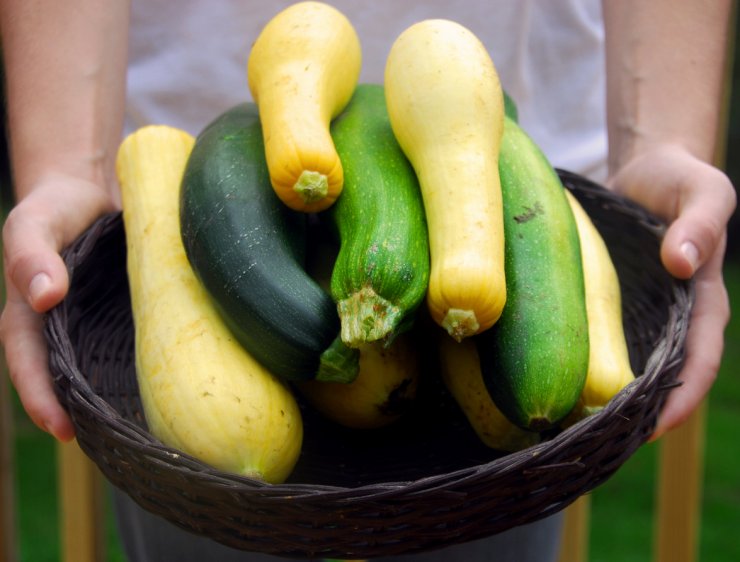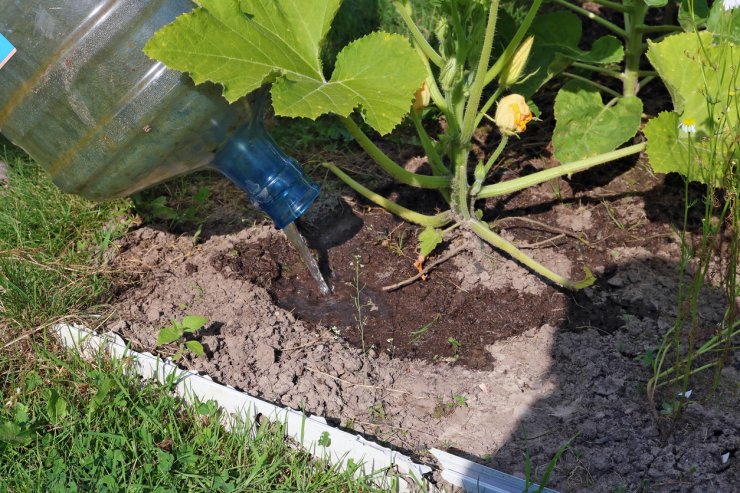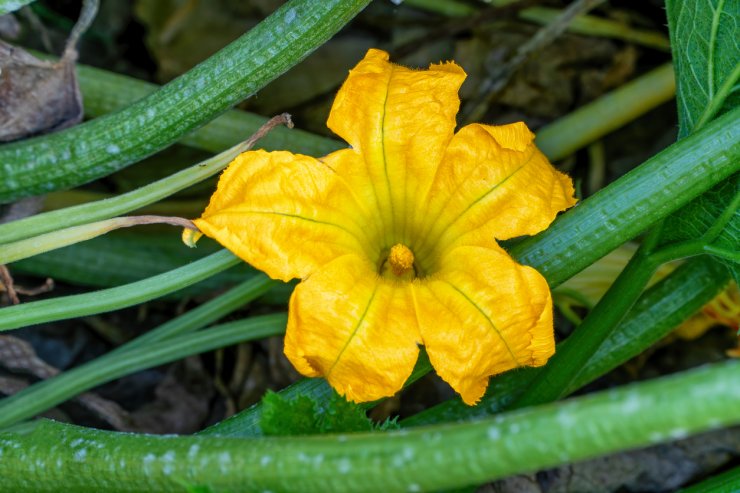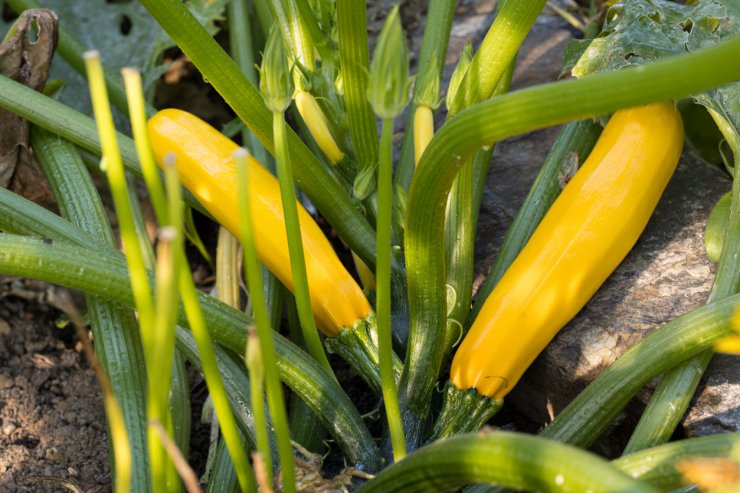
Basket of fresh summer squash.
The squash area should be kept free of weeds while the plants are young. Black-plastic or very heavy mulch is practical for such spreading vine plants, as weeding can be difficult.
Feed twice, immediately after thinning to the strongest three seedlings, and again just before the vines start to “run.”
Raise fruits off the ground to prevent rot. If you’re not using a trellis, carefully slide a piece of slate, tile, or plastic under each fruit. Avoid twisting or rolling the fruit so you don’t break the stem!
You can also use fabric row covers to boost and prolong yields. In cooler climates, keep row covers on all season long, except when female (fruit) blossoms open, then lift the cover for two hours in early morning twice a week to ensure bee pollination.
Watering and feeding your squash plants

The farmer pours from the watering bootle of a young seedling of a vegetable marrow
Squash love moist soil. Water very thoroughly whenever it’s dry, as 1 inch of water per week is ideal. Water most diligently when fruits form and throughout their growth period.
To put this into perspective, you’ll need to water mature squash plants once a week so the soil is moist 8 to 12 inches beneath the surface. If your soil is very sandy or the weather is hot, you’ll need to water more frequently.
Drip spikes attached to a drip irrigation system are an excellent way to ensure your squash plants get adequate water. You can also bury a perforated tin can beside your seedling at planting time, filling this can daily or a few times per week. Using this method, you’re sure to get water to your plants’ roots.
Rainwater is best for your garden plants. If it’s possible for you to collect rainwater, your squash will benefit from that!
Meanwhile, remove any weeds that manage to poke through. Top off mulches, using organic matter such as garden compost, to help roots stay cool and moist.
When the first blooms appear (which will be male flowers), apply a small amount of fertilizer as a side dress application. After harvest begins, fertilize occasionally for vigorous growth and lots of fruits. If your fruits are misshapen, they might not have received enough water or fertilization.
Hand-pollination

Summer squash blossom.
If your weather is cool and damp, you’re not seeing pollinators, or the female fruits are withering without getting pollinated, you can hand-pollinate your squash blossoms. Hand-pollination is best done early in the morning.
The easiest way to hand-pollinate squash plants is to use a paintbrush, toothbrush, or cotton swab, and gently transfer the pollen from the male flower (which has a long, thin stalk) to the female flower (which has a swollen, budding fruit at its base).
You can also remove the male blossom, pick off or pull back the petals, and rub the stamen against the pistil of the other flower.
Hand pollinating can help increase your yield, even when pollinators are present.
- Tip: If you often lack pollinators in your garden, consider interplanting flowers and squash to attract more varieties of bees. You can also let bee-friendly crops like cilantro, herbs, and kale go to seed before pulling spent plants.
Harvesting

Summer squash ready for harvesting.
Remember, summer squash is ready in 60 days or so, and is picked immature before fruits are fully formed. The skin should be soft and tender, otherwise the squash will be overripe and of poor quality. Fruits should be 4 to 8 inches long—resist the urge to let that zucchini become a baseball bat!
To harvest, use a sharp pair of shears or snippers to cut the fruit stem from the vine (don’t cut the vine). Leave 2 to 4 inches of stem for each squash and be careful not to break this off, as a broken stem creates a wound that starts to spoil immediately. Don’t carry squash by the stem.
The vines must be kept picked or the plants will stop producing, so pick early and often! Remember, squash grows quickly and may be too small to harvest only one day before it’s ready. Should you miss a picking or two, remove the overripe squash as soon as possible to reduce demands on the plants for moisture and nutrients.
Store your summer squash unwashed in the refrigerator for a week or so. Squash can also be frozen, or given away. Summer squash is very susceptible to frost and heat damage, so you do want to pick them all before the first fall frosts arrive.
A note about bitter squash:
If you harvest your squash and find that some of it tastes bitter, it’s because of cucurbitacins in the fruit. Squash contains these substances, probably to fend off animals who would ordinarily eat it. The levels increase to cause a bitter taste for humans usually because of some environmental stress, such as a large temperature flux or irregular watering.
Other causes could be a lack of nutrients or excessive pests or disease. For this reason, it’s even more important that you monitor your plants carefully for invaders and stick to a good watering routine. The cucurbitacins won’t hurt you in small amounts, but there’s a thing called toxic squash syndrome for a reason: You really shouldn’t eat the bitter squash.
Have you struggled with bitter squash? Tell us how you keep bitterness from developing in your crop.


 Previous
Previous

